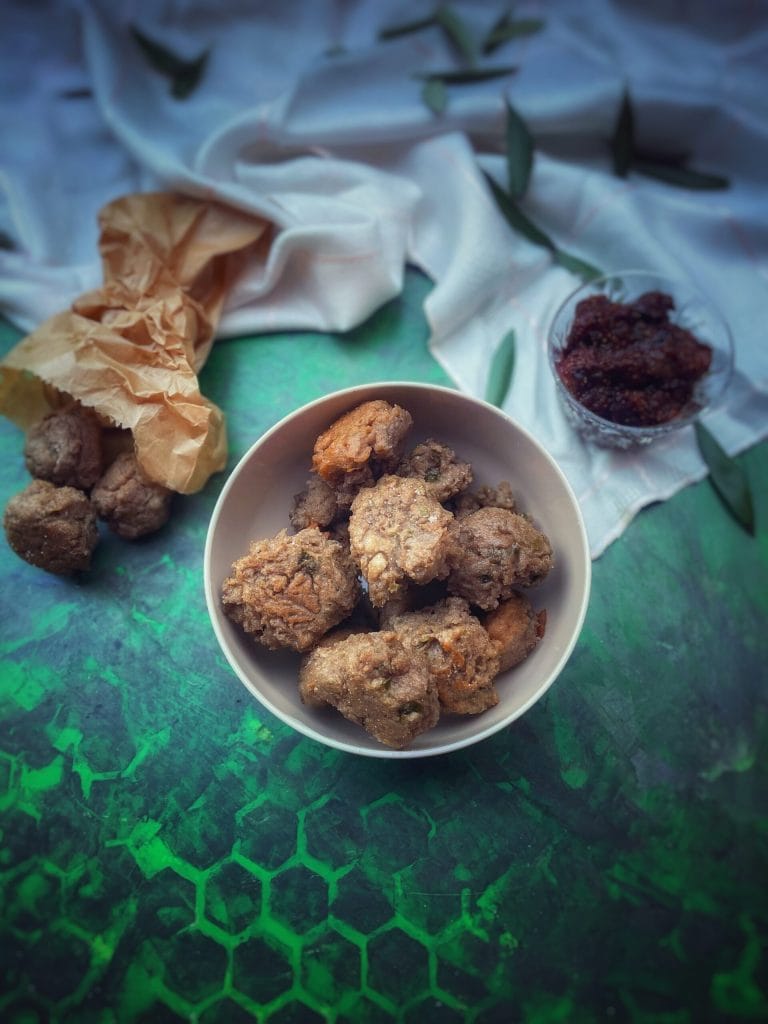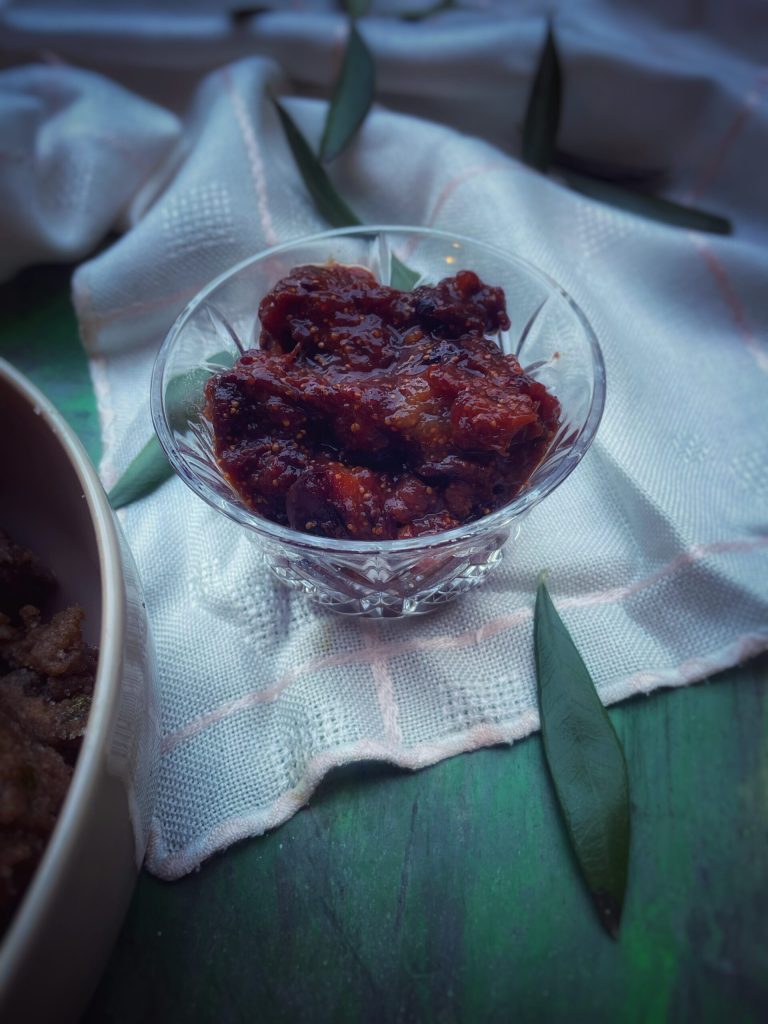My gluten-free seaweed fritters are inspired by the seaweed fritters of Diamante.
This Calabrian preparation uses local dry or rehydrated ulva seaweed, mixed into a fried batter that is simple, tasty, and rooted in the region.
They are a traditional Calabrian specialty typical of the seaside village of Diamante, on the Tyrrhenian coast of Cosenza province.
This dish combines the simplicity of fritter dough with the aroma of fresh seaweed gathered along the shores.
My version with a gluten-free flour mix uses dried sea lettuce flakes and gluten-free sourdough.
The fig sauce, which pairs well with the seaweed fritters, is inspired by the grape must mustard also known as Calabrian mustarda, typical of many rural areas, used with both sweet and savory dishes.
Here’s the recipe for the gluten-free sea lettuce fritters with sourdough and cooking with Magic Cooker (a lighter version than deep frying).

- Difficulty: Easy
- Cost: Economical
- Rest time: 4 Hours
- Preparation time: 5 Minutes
- Portions: 15 Pieces
- Cooking methods: Boiling, Frying, Other
- Cuisine: Italian
- Seasonality: All Seasons
Ingredients
- 4.2 oz gluten-free sourdough
- 5.3 oz gluten-free buckwheat flour
- 1.8 oz rice flour
- 1.8 oz potato starch
- 0.85 cup lukewarm water
- 1 teaspoon (salt)
- 1 teaspoon extra virgin olive oil
- 2 tablespoons sea lettuce flakes
- 8.8 oz figs
- 1 tablespoon red wine vinegar
- 1 tablespoon sugar
- 1 pinch salt
- to taste chili pepper
Tools
- 1 Lid Magic Cooker
Steps
Rehydrate the seaweed:
Place the flakes in a bowl with lukewarm water for 5–10 min.
Squeeze well and chop slightly.
Prepare the dough:
Dissolve the sourdough in water.
Add flour, starch, salt, oil, and seaweed.
Mix well until sticky dough forms.
Cover and let rise 3-4 hours.
Cooking with Magic Cooker:
Pour oil into the pan.
Heat the pan with the Magic Cooker lid on medium-low for 2–3 minutes until reaching a temperature of 207°F.
Turn off the heat, fry fritters by dropping spoonfuls into the oil and immediately covering with the Magic Cooker lid.
Cook 8/10 minutes per side, turning only once, until golden and cooked through.For traditional frying: fry the fritters in plenty of oil.

Chop the figs into pieces and place them in a small pot.
Add vinegar, sugar, salt, and (if desired) pepper or chili pepper.
Cook on low heat until it thickens like a compote (20–30 min).
Blend coarsely or leave rustic.
🖥You can purchase sea lettuce on the website www.algaulisse.it
with discount code ❌viaggiandomangiando❌
🖥And the Magic Cooker lid by clicking on the link.
💬 Curiosity:
In Diamante, during the Chili Pepper Festival, seaweed fritters are often served with spicy versions or with local cheeses.
The use of seaweed is local and identity-based, now rediscovered for its nutritional value.
The seaweed was collected by fishermen and local women, washed and chopped, and then mixed into the leavened dough.
They were a poor but nutritious dish, tied to the culture of reuse and respect for sea resources.
They were often prepared during popular festivals, Holy Week, or Ferragosto, as food to share with family or at the harbor.
FAQ (Questions and Answers)
Is Ulva seaweed (sea lettuce) and dried sea lettuce flakes the same seaweed?
Yes, Ulva seaweed and dried sea lettuce flakes are essentially the same thing, just in different forms:
✅ Ulva (sea lettuce):
It’s the botanical name for the genus of edible green seaweeds (e.g., Ulva lactuca)
Fresh, it resembles thin lettuce leaves, hence the name
✅ Dried sea lettuce flakes:
It’s dried and shredded Ulva
Used as a seasoning, in bread, pancakes, broths, soups, or dough
In cooking, they are the same ingredient:
→ flakes are just the ready-to-use version of Ulva, more practical for measuring.What is the difference between Diamante fritters and Neapolitan risen dough fritters?
Here are the main differences between Diamante fritters and Neapolitan risen dough fritters (also known as zeppulelle or pasta cresciuta):
– Diamante Fritters (Calabria)
Dough: flour, water, yeast, chopped seaweed (Ulva lactuca)
Flavors: garlic, parsley, sometimes chili pepper
Taste: marine, slightly savory
Origin: Tyrrhenian coast, poor man’s sea dish
Shape: irregular, spoonfuls
Occasion: popular festivals, summer, home cooking
– Neapolitan savory fritters (risen dough)
Dough: flour, water, yeast, salt
Flavors: sometimes pepper, rarely herbs
Variants: with seaweed (zeppulelle with seaweed), cicinielli (whitebait), ricotta, ham
Taste: neutral or slightly salty
Origin: Neapolitan street food
Shape: small, soft, round
Occasion: year-round, also sold in fry shops
▶️ Key Differences
Diamante fritters always use seaweed → it’s the identity ingredient
Neapolitan ones may contain seaweed, but not necessarily.
The Calabrian ones are more flavored (garlic, herbs), the Neapolitan ones are simpler or more versatile.

